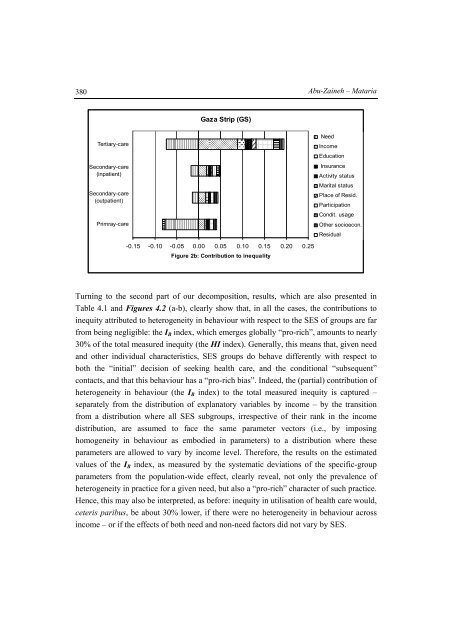The Palestinian Economy. Theoretical and Practical Challenges
The Palestinian Economy. Theoretical and Practical Challenges
The Palestinian Economy. Theoretical and Practical Challenges
You also want an ePaper? Increase the reach of your titles
YUMPU automatically turns print PDFs into web optimized ePapers that Google loves.
380<br />
Abu-Zaineh – Mataria<br />
Gaza Strip (GS)<br />
Tertiary-care<br />
Secondary-care<br />
(inpatient)<br />
Secondary-care<br />
(outpatient)<br />
Primray-care<br />
Need<br />
Income<br />
Education<br />
Insurance<br />
Activity status<br />
Marital status<br />
Place of Resid.<br />
Participation<br />
Condit. usage<br />
Other socioecon.<br />
Residual<br />
-0.15 -0.10 -0.05 0.00 0.05 0.10 0.15 0.20 0.25<br />
Figure 2b: Contribution to inequality<br />
Turning to the second part of our decomposition, results, which are also presented in<br />
Table 4.1 <strong>and</strong> Figures 4.2 (a-b), clearly show that, in all the cases, the contributions to<br />
inequity attributed to heterogeneity in behaviour with respect to the SES of groups are far<br />
from being negligible: the I B index, which emerges globally “pro-rich”, amounts to nearly<br />
30% of the total measured inequity (the HI index). Generally, this means that, given need<br />
<strong>and</strong> other individual characteristics, SES groups do behave differently with respect to<br />
both the “initial” decision of seeking health care, <strong>and</strong> the conditional “subsequent”<br />
contacts, <strong>and</strong> that this behaviour has a “pro-rich bias”. Indeed, the (partial) contribution of<br />
heterogeneity in behaviour (the I B index) to the total measured inequity is captured –<br />
separately from the distribution of explanatory variables by income – by the transition<br />
from a distribution where all SES subgroups, irrespective of their rank in the income<br />
distribution, are assumed to face the same parameter vectors (i.e., by imposing<br />
homogeneity in behaviour as embodied in parameters) to a distribution where these<br />
parameters are allowed to vary by income level. <strong>The</strong>refore, the results on the estimated<br />
values of the I B index, as measured by the systematic deviations of the specific-group<br />
parameters from the population-wide effect, clearly reveal, not only the prevalence of<br />
heterogeneity in practice for a given need, but also a “pro-rich” character of such practice.<br />
Hence, this may also be interpreted, as before: inequity in utilisation of health care would,<br />
ceteris paribus, be about 30% lower, if there were no heterogeneity in behaviour across<br />
income – or if the effects of both need <strong>and</strong> non-need factors did not vary by SES.
















